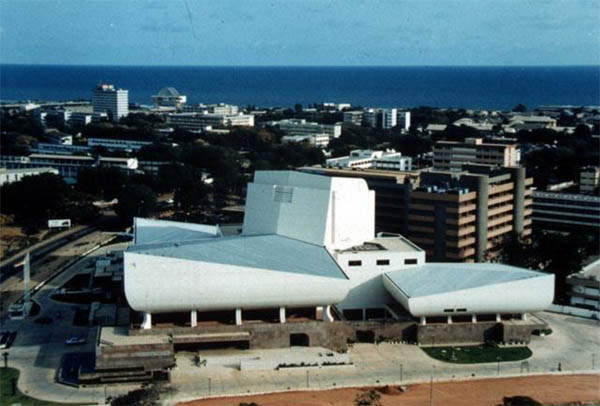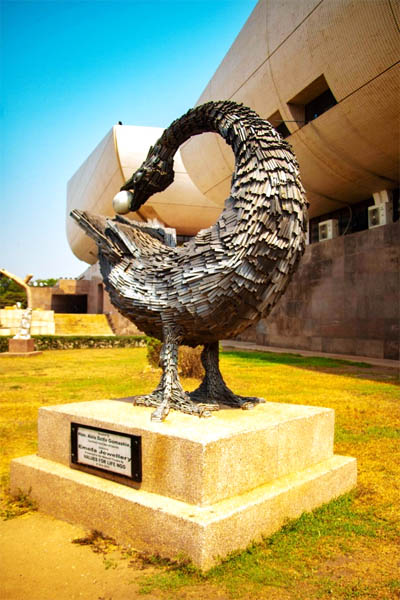This essay seeks to draw readers’ attention to the National Theatre of Ghana in order to recognize its relevance within the country’s visual cultural landscape. The National Theatre is a monumental edifice situated in the nation’s capital, Accra. It is supported by the government, and largely devoted to musical performances and stage productions, among others (Wilson, 1988). Theatrical performances in the National Theatre are part of the nation’s cultural heritage and present the people with creative thoughts and reflections on life. The establishment of the National Theatre of Ghana was, to a large extent, largely supported by the National Theatre Movement of the 1950s by cultural experts like Efua Sutherland and Professor J. H. Kwabena Nketia (Agovi, 1990).
The National Theatre was completed on December 16, 1992, commissioned and handed over by the Peoples Republic of China to the Government of Ghana on December 30, 1992 (www.nationaltheatre.gov.gh/history/ retrieved 2020, August 7). The Theatre was designed to be used by people from all walks of life and diverse age groups. Since its inception, the National Theatre has hosted a number of performances and exhibitions from both local and international communities with the intention of promoting visual culture in a heterogeneous global landscape.
Location, Structure, and Artistic Appreciation
The boat-like building is located near the junction of Liberia Road and Independence Avenue, adjacent to Efua Sutherland Children’s Park, in Accra’s central district.
Three distinct structural forms comprise The National Theatre building, with each structure housing its own performance group/company: the National Theatre Players, National Dance Company, and the National Symphony Orchestra. A closer look at the entire structure reveals three distinct parts aside from the structural forms mentioned earlier. The upper part portrays three boats joined together, supported by rectangular piers with curved outward projections, and a rectangular base with entrance and exit openings. In fact, the entrances and windows seem to be carved out of the rectangular base. All of the entrances are elevated from the ground level with a staircase, which leads up to the glass entrances and into the building (https://3rdworldarchitecture.wordpress.com/2018/02/04/national-theatre-of-ghana/ retrieved 2020, August 7). The base is designed to create a projection at the entrance that provides visitors with the necessary protection from inclement weather.

National Theatre. Aerial view over National Theatre. Photo: Cheng Taining, 1997, link: https://archnet.org/sites/1413/media_contents/15315.
Above the base, there are distinct white forms. They taper upwards from the centre and meet towards the outside of the base. The walls curve inwards and are lifted just above the solid base, with glass in between them, making the base and white forms more distinct and thereby reinforcing the differences between them. Small white tiles cover these forms, giving the building its shape and colour. A closer look at the shape of the National Theatre reveals a display of three boats/canoes or fishing vessels that meet at a central point, which takes the form of a captain's bridge. The entire structure is supported by curvy piers and rests on a rectangular base as presented in the image above.
A careful study of the architectural ‘language’ of the National Theatre reveals a combination of interior and exterior Asian architecture, symbolic Ghanaian forms and boat construction. Generally, Chinese architecture is based on the relevance of influential local cultural traditions and adherence to hierarchy (Lianto, 2020). It prioritizes spatial designs with balanced symmetrical central pivots and a reverence for nature and aesthetics. Additionally, the dominant use of red represents happiness, which is also found throughout the interior of the National Theatre.
The curvy structure of the theatre in general nods towards Asian architecture. The seating space is segmented along stepped floors and the undulating structured ceiling is reminiscent of waves with openings defined by lighting systems. In fact, the use of sculptural forms and other Ghanaian art works effectively combine with the architectural structure to convey the visual cultural landscape of the National Theatre.
Sculptures in Public Space
Sculptural forms executed by Ghanaian artists are carefully displayed outside the National Theatre. The following image shows a sculptural work that depicts a Sankofa, a traditional Ghanaian symbol.

Emefa Jewellery, Sankofa, 2015, H: 11ft., Presented by Values for Life NGO to the National Theatre, Photo: Wisdom Dzigbordi.
The Sankofa represents taking the opportunity to reflect upon the past and applying significant and relevant ideas to current developments. Thus, the past has something relevant that must be considered and utilized as part of contemporary practice.
Education and Cultural Relevance
The National Theatre of Ghana is a significant cultural centre in Accra, Ghana and the entire form of this visual cultural structure provides people from diverse walks of life a place for entertainment and relaxation. The building is a visual architectural icon for the city and is an influential hub for creative art performances. It therefore serves as an important edifice to promote the arts, offering both Ghanaian and foreign artists a place to express their creativity.
In addition to providing entertainment and relaxation, the theatre seeks to educate people and stakeholders (who periodically use the place) on the responsibility of the National Theatre of Ghana as a strong cultural institution that ensures the development of culture, including the performing arts, and the need to respect cultural values. Through this education, the activities of the theatre are brought into focus, preserved, promoted and transmitted to the next generation for posterity and the promotion of visual culture across the world.
References
- Agovi, K. E. (1990). The origin of literary theatre in colonial Ghana, 1920-1957. Research Review, 6(1), 1-22.
- Frimpong, M. (2015). Towards an audience development plan for the National Theatre of Ghana. Unpublished Thesis. University of Ghana, Legon.
- Lianto, F. (2020, August 9). Building structure system of Chinese architecture, past and present. Retrieved from https://www.academia.edu/33602498/BUILDING_STRUCTURE_SYSTEM_OF_CHINESE_ARCHITECTURE_PAST_AND_PRESENT
- National Theatre of Ghana (2020). History of the National Theatre of Ghana. Retrieved on January 10, 2020 from http://www.nationaltheatre.gov.gh/history
- Wilson, E. (1988). The theatre experience (4th ed.). New York: McGraw-Hill Book Company.
- 3rdworldarchitecture.wordpress.com (2018, January 4). National Theatre of Ghana. Retrieved from https://3rdworldarchitecture.wordpress.com/2018/02/04/national-theatre-of-ghana/
published August 2020



